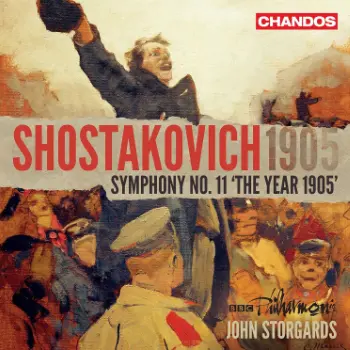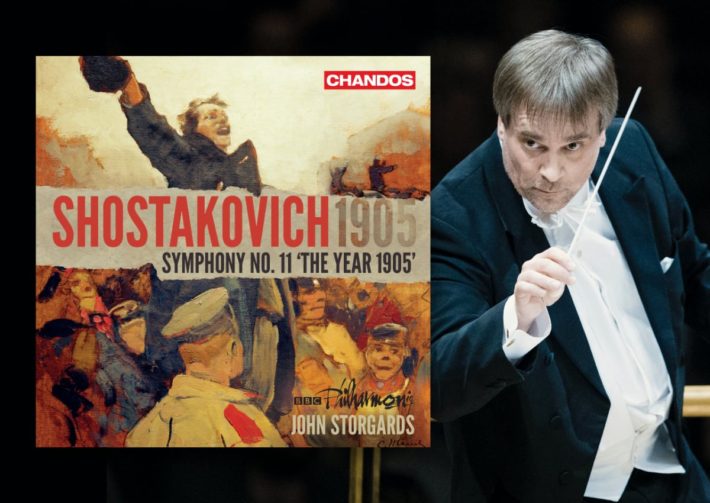Shostakovich’s eleventh symphony has long divided musicologists, who debate its worth. Is it propaganda? Was Shostakovich finally giving in to the authorities? Is it movie music without a movie? Where is the emotional depth we hear in the Fifth, Eighth and Tenth Symphonies? These questions have, to some extent, been answered in the last 12 years by two recordings that mined a heretofore undiscovered profundity from the score: The Royal Liverpool Philharmonic led by Vasily Petrenko on Naxos, and the Boston Symphony Orchestra led by Andris Nelsons, part of their ongoing cycle for DG.

Both performances feature exceptional playing and flowing tempos (Petrenko 57’37” and Nelsons 62’39”) that give the work a coherent symphonic structure. In comparison, Rostropovich’s last recording with the London Symphony Orchestra, widely acclaimed at the time of its release, seems episodic and disjointed at 72’24”, while the recorded sound (recorded live at London’s Barbican) is disappointing.
Storgårds’ tempos fall somewhere in the middle (66’43”), yet the music never feels slow, and the musical argument rarely falters. His opening movement features intensely beautiful string playing, dynamics at pianissimo for most of its duration. Both Nelsons and Storgårds add almost 4 minutes to Petrenko’s overly quick reading (13’46”), using the extra time to create a more foreboding atmosphere. What perhaps lifts this new performance above Nelsons/DG is the recorded sound. Deutsche Gramophone successfully creates a wide soundstage without a corresponding sense of width (front to back perspective). The Chandos soundstage has both, and that adds a glow and warmth to the orchestra that is lacking in the DG recording.
Related Classical Music Reviews
- Review: Shostakovich – String Quartets No. 2, 7 & 8 – Pavel Haas Quartet
- Review: Bartók – Concerto for Orchestra, Suite No. 1 – Dausgaard
- Review: Weinberg – Symphony No. 2 & 21 – Mirga Gražinytė-Tyla
Both Petrenko and Nelsons play the second movement in less than 19 minutes, whereas Storgårds takes a little over 21 minutes. Yet Storgårds’ sure control of the line makes it work. Aided by resplendent, indeed, cinematic Chandos sound, the January 22, 1905 events at the winter palace (known as Bloody Sunday) are vividly brought to life. Listen to the biting exchange between brass and lower strings at 2’10”, which then builds to a tremendous climax at 2’36”. Some listeners might sense a drop in intensity after the climax, but the characterful playing of the BBC winds propel the music towards its next climax at 7’25” (the trombones particularly prominent). The music then winds down to a more static, icier passage, the exchanges between snare drum and plucked strings mechanic and emotionless.
The next build-up begins at 11’59” as the snare drum suggests gunfire while the strings begin one of those unrelenting marches that so often feature in Shostakovich’s symphonic writing. The orchestral playing is vividly intense, the trombone glissandos (13’55”) snarling out the rage of the protestors, leading into a shattering climax as the soldiers slaughter them. Here Petrenko’s faster tempo (13’44”) intensifies the inhumanity of it all, but the scene is still powerfully affecting in Storgårds’ reading.
The third movement, “Eternal Memory,” benefits again from a slightly slower tempo and the greater flexibility of line that Storgårds allows himself. Nelsons is particularly strong in this movement, and the Boston Symphony playing is astounding – if there is a reason to prefer the Storgårds performance, it is the superior Chandos sound, which makes the climax that begins at 7’45” overwhelming in its impact. It is a close knot thing in the final movement – all three performances offer compelling readings, though Nelsons’ deliberate opening tempo is unconvincing.
The liner notes all suggest a theme of defiance in the final movement, and the headlong rush of the Petrenko and Nelsons performances make that defiance seem almost machinelike and bloodless. Storgårds somehow engenders a more human and optimistic feeling, and the clanging bells are thrillingly caught (the conductor uses four church bells rather than the standard orchestral tubular bells).
Listeners now have the luxury of three outstanding recordings of this once undervalued work – highly recommended, and let’s hope it we get more Shostakovich from these forces.

Album Details |
|
|---|---|
| Album name | Shostakovich – Symphony No. 1 – The Year 1905 |
| Label | Chandos, CD CHSA5278 |
| Artists | BBC Philharmonic, John Storgårds |
Included with an Apple Music subscription:
Available on Presto Music
Latest Classical Music Posts



















